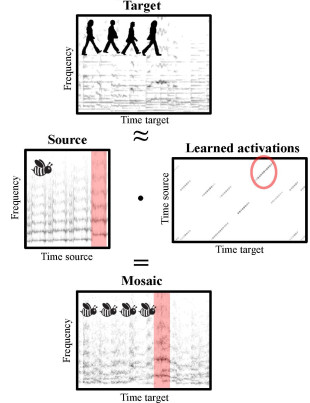Let it Bee - Towards NMF-inspired Audio Mosaicing
This is the accompanying website for the paper:
- Jonathan Driedger, Thomas Prätzlich, and Meinard Müller
Let It Bee — Towards NMF-Inspired Audio Mosaicing
In Proceedings of the International Society for Music Information Retrieval Conference (ISMIR): 350–356, 2015. PDF Demo@inproceedings{DriedgerPM15_AudioMosaicingNMF_ISMIR, author = {Jonathan Driedger and Thomas Pr{\"a}tzlich and Meinard M{\"u}ller}, title = {{L}et {I}t {B}ee -- Towards {NMF}-Inspired Audio Mosaicing}, booktitle = {Proceedings of the International Society for Music Information Retrieval Conference ({ISMIR})}, address = {M{\'a}laga, Spain}, year = {2015}, pages = {350--356}, url-demo = {https://www.audiolabs-erlangen.de/resources/MIR/2015-ISMIR-LetItBee}, url-pdf = {2015_DriedgerPM_AudioMosaicingNMF_ISMIR.pdf} }
Abstract

A swarm of bees buzzing "Let it be" by the Beatles or the wind gently howling the romantic "Gute Nacht" by Schubert - these are examples of audio mosaics as we want to create them. Given a target and a source recording, the goal of audio mosaicing is to generate a mosaic recording that conveys musical aspects (like melody and rhythm) of the target, using sound components taken from the source. In this work, we propose a novel approach for automatically generating audio mosaics with the objective to preserve the timbre of the source in the mosaic. Inspired by algorithms for non-negative matrix factorization (NMF), our idea is to use update rules to learn an activation matrix that, when multiplied with the spectrogram of the source recording, resembles the spectrogram of the target recording. However, when applying the original NMF procedure, the resulting mosaic does not adequately reflect the timbre of the source. As our main technical contribution, we propose an extended set of update rules for the iterative learning procedure that supports the development of sparse diagonal structures in the activation matrix. We show how these structures better retains timbral characteristics of the source in the resulting mosaic.
Audio Examples
In the following you find the audio examples corresponding to Table 1 in the paper. You can also download all files as [.zip].
Example: Mosaic of LetItBe with Bees
|
[Target] LetItBe
|
[Source] Bees
|
|
|
|
Click the button in the middle to activate the player.
Example: Mosaic of GuteNacht with Wind
|
[Target] GuteNacht
|
[Source] Wind
|
|
|
|
Click the button in the middle to activate the player.
Example: Mosaic of FunkJazz with Whales
|
[Target] FunkJazz
|
[Source] Whales
|
|
|
|
Click the button in the middle to activate the player.
Example: Mosaic of Stepdad with Chainsaw
|
[Target] Stepdad
|
[Source] Chainsaw
|
|
|
|
Click the button in the middle to activate the player.
Example: Mosaic of Freischütz with AirRaid
|
[Target] Freischütz
|
[Source] AirRaid
|
|
|
|
Click the button in the middle to activate the player.
Example: Mosaic of Vermont with RaceCars
|
[Target] Vermont
|
[Source] RaceCars
|
|
|
|
Click the button in the middle to activate the player.
HAMR
The core ideas of this work were born at the "Hacking Audio and Music Research" Hackathon event hold at ISMIR 2014 in Taipei. Check out our project from back then here.


